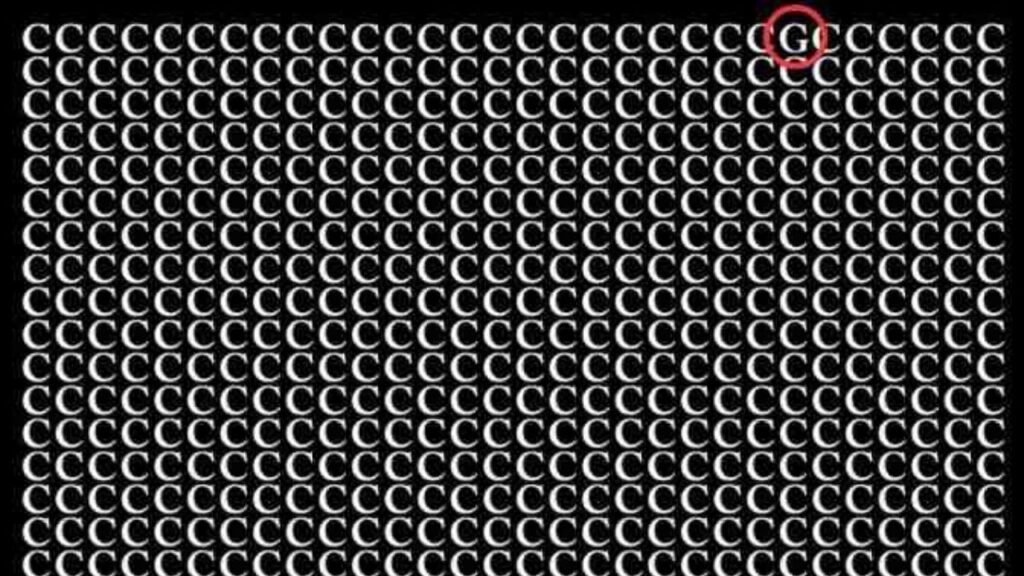The Fascinating World of Optical Illusions
Our brains are incredible machines that process visual information at lightning speed. Sometimes, however, they can be tricked by clever patterns and designs that challenge our perception.
Optical illusions have captivated humans for centuries, serving as both entertainment and scientific tools. These visual puzzles reveal how our minds interpret the world around us.

What Makes This Challenge Special?
This particular letter-spotting challenge presents a grid filled with identical characters. Hidden among them lies one different letter that breaks the pattern.
The human eye naturally seeks patterns and similarities. When faced with repetitive elements, our brain often overlooks subtle differences.
The Science Behind Visual Perception
Pattern recognition is a fundamental cognitive skill that develops from early childhood. Our brains are wired to identify familiar shapes and forms quickly.
This evolutionary trait helped our ancestors survive by recognizing threats and opportunities. Today, it forms the basis of many intelligence tests and brain training exercises.
Understanding IQ Tests Through Visual Puzzles
Intelligence quotient tests measure various cognitive abilities including spatial awareness and attention to detail. Visual puzzles like this one tap into these specific skills.
Traditional IQ assessments often include pattern completion and anomaly detection tasks. These exercises evaluate how well someone can process visual information under time pressure.
Types of Visual Intelligence Challenges
Spot-the-difference puzzles represent one category of visual intelligence tests. They require sustained attention and systematic scanning techniques.
Letter recognition tasks specifically target our ability to distinguish between similar shapes. The difficulty increases when characters share common features.
Why 37 Seconds Matters
Time limits add psychological pressure that reveals true cognitive processing speed. Thirty-seven seconds provides enough time for careful observation without allowing excessive deliberation.
Research shows that most people can complete simple visual tasks within this timeframe. Those who succeed faster often demonstrate superior visual processing abilities.
Strategies for Solving Letter Puzzles
Systematic scanning proves more effective than random searching when tackling these challenges. Start from one corner and move methodically across the grid.
Many puzzle solvers make the mistake of rushing through the image. Patience and focus typically yield better results than hasty examination.
The Grid-by-Grid Method
Divide the visual field into smaller sections for easier analysis. Mental segmentation helps prevent eye fatigue and improves accuracy.
Focus on one quadrant at a time rather than attempting to process the entire image. This approach reduces cognitive overload and increases success rates.
Common Mistakes to Avoid
Tunnel vision occurs when solvers focus too intensely on specific areas. This narrow focus can cause them to miss obvious anomalies elsewhere.
Another frequent error involves assuming the different letter appears in predictable locations. Random placement is typically used to increase difficulty.
The Psychology of Pattern Recognition
Human brains excel at identifying familiar patterns through a process called template matching. We compare incoming visual data against stored mental templates.
This cognitive shortcut usually serves us well in daily life. However, it can work against us in puzzles designed to exploit these automatic processes.
How Context Affects Perception
Surrounding elements significantly influence how we perceive individual characters. Letters may appear different depending on their neighboring symbols.
This phenomenon, known as contextual processing, explains why some people struggle with these challenges. The brain prioritizes overall patterns over individual details.
Training Your Visual Skills
Regular practice with visual puzzles can improve pattern recognition abilities over time. Like physical exercise, mental training produces measurable improvements.
Daily brain training through various puzzle types strengthens different cognitive pathways. This cross-training approach enhances overall mental flexibility.
The Role of Attention in Visual Tasks
Selective attention determines what information our brains prioritize during visual processing. Distractions can significantly impact performance on timed challenges.
Environmental factors like lighting, screen quality, and viewing angle also affect visual acuity. Optimal conditions improve success rates considerably.
Concentration Techniques
Deep breathing before attempting visual puzzles helps calm the mind and improve focus. Relaxed mental states often produce better results than anxious ones.
Eliminating distractions creates ideal conditions for concentrated effort. Turn off notifications and find a quiet space for maximum effectiveness.
The Impact of Fatigue
Mental exhaustion dramatically reduces performance on attention-demanding tasks. Fresh minds process visual information more efficiently than tired ones.
Eye strain from prolonged screen time can also impair letter recognition abilities. Regular breaks help maintain peak visual performance.
Different Skill Levels and Expectations
Beginners should not feel discouraged if they cannot complete the challenge within the time limit. Visual skills develop gradually through consistent practice.
Experienced puzzle solvers often complete these tasks in half the allotted time. Their trained eyes quickly identify anomalies that others might miss.
Age and Visual Processing
Younger individuals typically demonstrate faster visual processing speeds due to neuroplasticity advantages. However, older adults often compensate with superior pattern recognition experience.
Children may struggle with sustained attention requirements despite having excellent visual acuity. Adults balance speed with systematic approaches more effectively.
Individual Differences in Visual Skills
Some people possess naturally superior spatial intelligence that aids in visual puzzle solving. These individuals often pursue careers requiring strong visual-spatial skills.
Learning disabilities can affect visual processing abilities in various ways. However, targeted training can help individuals overcome many of these challenges.
The Hidden Answer Revealed
After careful examination of the puzzle grid, the different letters appear in the fourth row from the top. It stands out subtly from the surrounding identical characters.

Most successful solvers identify this anomaly by systematically scanning each row rather than jumping randomly around the image. Patience proves more valuable than speed in these detailed recognition tasks.
Benefits of Regular Brain Training
Cognitive exercises like optical illusions provide measurable benefits for mental sharpness and problem-solving abilities. Regular practice strengthens neural pathways associated with visual processing.
Memory improvement often results from consistent brain training routines. The same attention skills used in visual puzzles transfer to other cognitive domains.
Real-World Applications
Professional benefits include improved attention to detail in work situations requiring visual accuracy. Fields like graphic design, architecture, and quality control all rely on these skills.
Daily life improvements manifest as better navigation abilities, enhanced reading comprehension, and increased awareness of environmental details.
Building Mental Resilience
Challenge acceptance through puzzle-solving builds psychological resilience and confidence in problem-solving abilities. These traits transfer to other life areas requiring persistence.
Stress reduction often results from engaging in mentally stimulating activities that provide clear goals and immediate feedback. Brain games offer healthy escapism from daily pressures.
Creating Your Visual Challenges
Designing personal puzzles can enhance understanding of visual perception principles while providing customized difficulty levels. Simple tools allow anyone to create effective brain training exercises.
Varied difficulty levels keep challenges engaging without becoming frustrating. Progressive complexity maintains motivation while building skills systematically.
Embracing Visual Intelligence
Optical illusion puzzles represent just one facet of human cognitive ability, yet they reveal profound insights about brain function and visual processing. Whether you spotted the odd letter quickly or needed extra time, every attempt strengthens your mental capabilities.
Regular engagement with these challenges provides lasting benefits that extend far beyond puzzle-solving success. Your brain craves stimulation, and visual puzzles deliver exactly the right type of cognitive workout needed for optimal mental health and intellectual growth.
